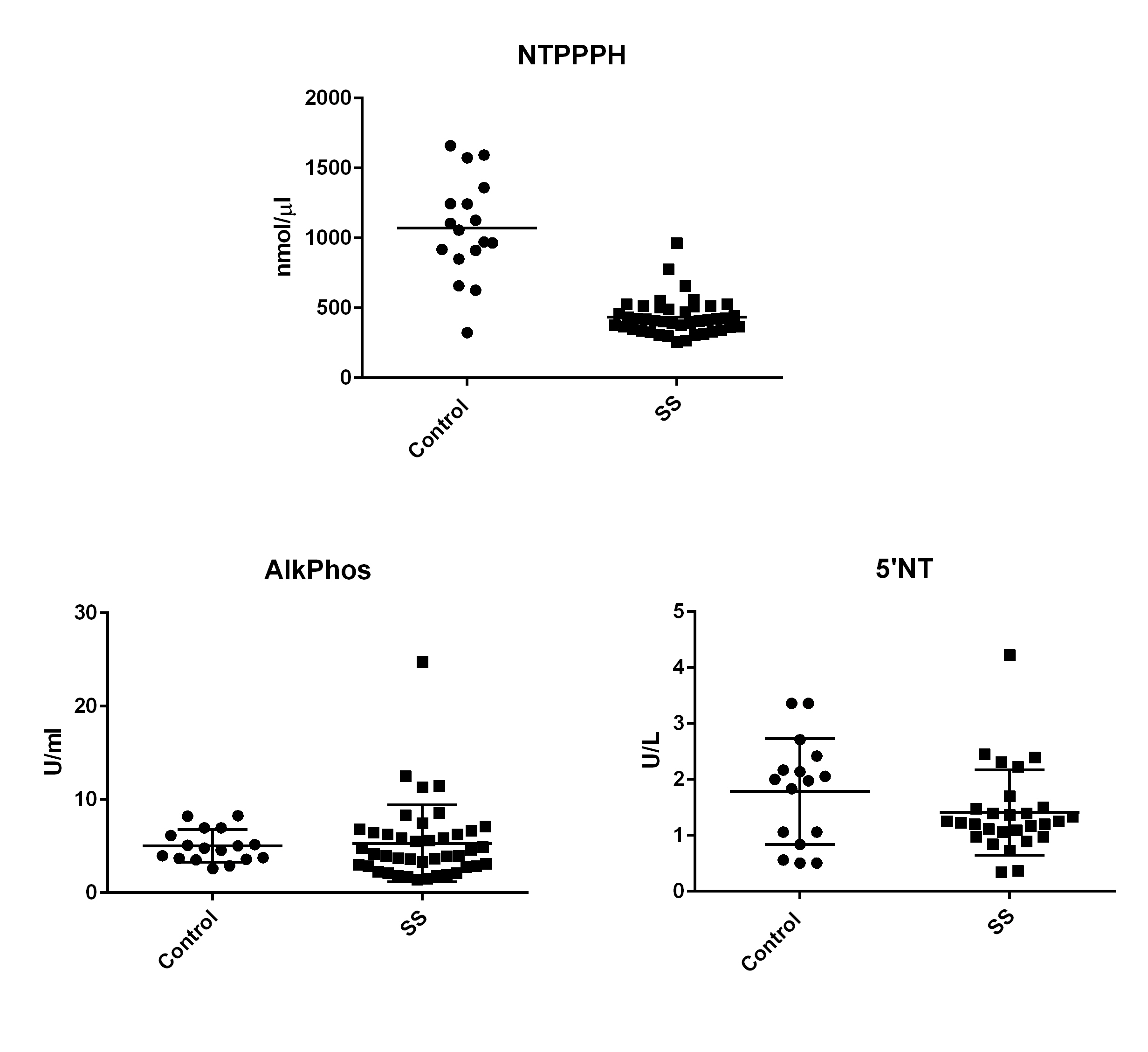Session Information
Session Type: ACR Poster Session A
Session Time: 9:00AM-11:00AM
Background/Purpose:
Calcinosis is a major source of morbidity in patients with systemic sclerosis (SS). In addition, increased coronary calcification has been reported in patients with SS and other inflammatory diseases. The etiology of pathologic calcification in SS is unclear. Circulating levels of inflammatory cytokines, including interleukins, are elevated in SS patients compared to controls. IL-1β can induce calcification in vitro. The mechanism of this effect was recently shown to involve modulation of nucleoside triphosphate pyrophosphohydrolase (NTPPPH) activity. This critical ecto-enzyme hydrolyzes extracellular ATP to produce pyrophosphate (PPi). PPi functions as a potent inhibitor of calcification. Thus, low levels of NTPPPH reduce PPi levels and permit increased mineralization. We sought to test the hypothesis that circulating NTPPPH enzyme activity levels are reduced in SS patients.Methods:
After obtaining informed consent, 20 ml of blood was collected from 42 well-characterized SS patients and 17 healthy controls with similar mean age and gender. For completeness, we measured serum activity levels of three enzymes involved in PPi metabolism. PPi is generated from ATP through the action of NTPPPH. PPi is degraded by alkaline phosphatase (Alk Phos) to Pi. 5′- nucleotidase (5’NT) drives PPi production by metabolizing AMP to adenosine and Pi. Specific activities of Alk Phos (Sigma) and 5’NT (BQ Kits) were measured per manufacturers’ directions and NTPPPH activity levels were measured with a colorimetric assay.Results: Characteristics of the patients are shown in table 1. The mean values of PPi-metabolizing enzyme activity levels in sera of patients with SS are shown in the scatter plots in figure 1. NTPPPH levels were significantly lower (p= <0.0001) in SS patients compared to controls. There were no significant differences in levels of Alk Phos (p=0.11) and 5’NT (p=0.181).
Conclusion: NTPPPH activity levels are significantly lower in patients with SS compared to controls, leading to lower PPi levels and more pathologic calcification. This work provides additional support for the important connection between inflammation and mineralization, and identifies NTPPPH enzymes as potential targets for novel therapies for SS-associated calcification. Table 1. SS patient characteristics
| Patient Characteristics | |
| Age (years) | Mean 55.5 (range 21-78) |
| Women/Men | 34/8 |
| Disease Duration (years) | Mean 10.8 (range 1-31) |
| Limited | 15 |
| Diffuse | 20 |
| Systemic sclerosis sine scleroderma | 2 |
| Overlap | 5 |
Figure 1. Scatter plot of activity levels of PPi-metabolizing enzymes in SS patients and controls.
To cite this abstract in AMA style:
Ding Y, Yeturi S, Gohr C, Csuka ME, Rosenthal AK. Low Nucleoside Triphosphate Pyrophosphohydrolase Activity Contributes to Pathologic Mineralization in Systemic Sclerosis [abstract]. Arthritis Rheumatol. 2016; 68 (suppl 10). https://acrabstracts.org/abstract/low-nucleoside-triphosphate-pyrophosphohydrolase-activity-contributes-to-pathologic-mineralization-in-systemic-sclerosis/. Accessed .« Back to 2016 ACR/ARHP Annual Meeting
ACR Meeting Abstracts - https://acrabstracts.org/abstract/low-nucleoside-triphosphate-pyrophosphohydrolase-activity-contributes-to-pathologic-mineralization-in-systemic-sclerosis/

